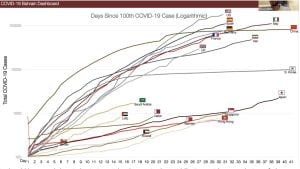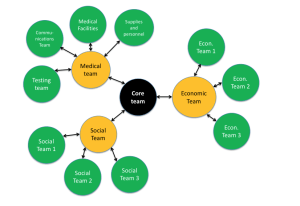written by Matt Andrews
Hamad Almalki is the Undersecretary for National Economy at Bahrain’s Ministry of Finance and National Economy. He is a graduate of the Edward S. Mason mid-career Masters in Public Administration program at the Harvard Kennedy School.
My Zoom interview captures Hamad’s reflections (as of April 3) on Bahrain’s response to the covid-19 pandemic. It is an interesting case, especially because Bahrain has –to date—managed to control the crisis better than most other countries (as evidenced in the relatively flat curve here—the red line at the bottom of the chart, showing the situation on April 2-3).

It should be noted that Bahrain is an island-state in the Middle East with a population of about 1.5 to 2 million people. That makes it about the same size as Philadelphia in the United States, or just more than twice the size of Boston. It is similar in size, or larger, than many countries (including Latvia, Estonia, Trinidad and Tobago, Timor-Leste, Cyprus, Mauritius, Malta, Iceland, and more). I make this observation because the case will be more relevant to specific places or levels of government than others (as with all cases).
This post works progressively through different parts of the interview, such that readers (and listeners) can more easily digest thoughts emanating from the full 1.5 hours. As with all blog posts, I conclude with a set of questions for reader reflection.
PART 1. A strong, inclusive, coordinated head start
Bahrain began preparing for the Covid-19 crisis 3 weeks before they experienced the first case. They “watched China very closely” and knew it was just a matter of time before the virus came to their shores. A 24 hour War Room was operational by February 13, coordinating an inclusive, varied group of experts focused on three streams of work – medical, economic, and social. The focus on all three streams from the start has meant that Bahrain has been able to balance concerns in all three streams at all times.
It is interesting that they included the media in the War Room, from the very beginning. The reasons are multiple: They did not want conflicting messages, and recognized that the challenge in crisis is to build confidence and be transparent. Also, they wanted messages and news to get out rapidly (“if you wait, people speculate, things do wrong”). The media were key to building consistent and fast messaging. As Hamad notes, the key is to let people “know where they are going” as you move through the crisis.
The early response also involved establishing a War Room at the airport, given that they knew the virus would probably enter through the airport. This War Room established a highly integrated approach to stitch all airport services together into one effort to identify and manage the virus at point of entry. As Hamad says, it’s about “coordination, coordination, coordination.”
PART 2. Quick, agile responses after the first case
Bahrain recorded its first Covid-19 case on February 24. Their early stage preparation meant that the case could be identified and quickly responded to. The coordination of social and medical work streams also meant that government could quickly blend its responses; initial social distancing measures were introduced (including closing schools) and the country started ramping up its hospital and testing capacity.
Their approach to building capacity was not to wait for perfect hospitals, mobile testing mechanisms etc. Instead, they worked fast, developing what agile practitioners might call minimum viable products, designed to get into the arena fast (for example, their mobile testing mechanism was a rented bus with a doctor and nurse and swabs and tests). This “just do it” attitude is vital in the face of crisis; identify the basics you need, and put them together from what you have (this attitude reminds me of one of my favorite scenes in a movie called Apollo 13—the square peg in round hole scene—where engineers are charged with “making this [a big square] fit into the hole for this [a small cylinder] using nothing but that [a variety of seemingly useless material]”. Watch the scene (sorry to distract from the Bahrain story).
Back to the Bahrain story, where Hamad describes ideas emerging, being authorized, and put into practice rapidly. These have included field hospitals, mobile testing, websites, and more. Listen to Hamad describe it all:
Here is a video showing a field ICU that the Bahrain government has created in a parking lot.
PART 3. Social distancing measures were based on “collective” “fact-based” decisions
In this third part of the interview Hamad discusses the government’s early steps to cancel events (like the Formula 1 Grand Prix) and expand suppression mechanisms and social distancing. He notes that decisions were inclusive and participatory, or “collective”, and “based on facts and data” about the spread of the virus. The twice weekly national executive meetings were used to provide opportunity for discussion, debate and analysis, and generated decisions.
The social measures also involved organizing ways of bringing Bahraini citizens back to the country and mobilizing volunteers—where citizens could offer help to the process. Hamad notes that, “Everybody wants to help … I have never seen it in my life.”
PART 4. Social and economic responses were coordinated early on
The “coordinated strategy from early on” allowed government to introduce economic measures on the exact same day that they called for many businesses to close. This was key to allaying citizen and business fears and concerns about the economic costs of social distancing. It was possible “because the [multi-steam] policy ideas had been in preparation” for weeks.
Other social measures affected the religious community, where leaders stepped up and took the initiative to support and even propose adaptations needed in the face of the virus.
By this stage, there was a high degree of socialization and social buy-in to the crisis response.
Part 5. Organizing work in various streams and watching the data
The coordinated response adopted by Bahrain was significantly because of the aggressive work that had already been undertaken simultaneously along different work streams. Remember, these included medical, economic, and social. Hamad describes the four major medical sub-workstreams; testing, communications, medical facilities, supplies and personnel. Note how this idea of streams and sub-streams relates to the snowflake organizational structure of distributed teams discussed in prior blog posts. My own rendering of this structure is below—the idea is to mobilize as much energy as possible into your system in a flat, fast and flexible structure (but with clear decision-making and coordination processes).

I was particularly interested in Hamad sharing about their medical communications sub-stream activities. In particular, the team emphasized two-way communication, with government sharing and soliciting information. The ‘listening’ part of their communication strategy is particularly vital to their overall approach: they want citizens to provide information to the policy process from the bottom up, as the policy must affect people at the grass roots.
I was also intrigued by the many different measures they are using to gather data—hotlines, apps, digital data from bracelets, etc. As with the Liberia case a few blogs ago we can see that the Bahrain officials want to get as much real time information as possible to learn what the virus is doing, how people are reacting, etc. Information is crucial in a crisis (because you are making sense of the threat as you act). Hamad notes that the communications strategy is key to being prepared “for the next phase”: “we are always trying to be ready for the next phase.”
Hamad also discusses the kinds of indicators they focus on (and report on)—including cases, deaths, and tests per capita. Bahrain has thus far conducted about one test for every 46 people (34,860 tests for about 1.6 million people), which is much better than other countries (the United States was—at the same time—testing 1 in 273 people, the UK 1 in 404, South Korea 1 in 104, and Germany 1 in 90 (according to National Public Radio).
Hamad discusses the dashboard decision makers are using to track key data. This dashboard helps them know how the problem is being addressed and helps them learn in real time.
PART 6. Data, awareness, and learning
In part 6 of the interview Hamad continues discussing the importance of data and the dashboard. In particular, he notes how vital it is to trace each case and use data from the tracing to build awareness amongst the public and to learn about the virus. The data gathering is “part of being transparent and making sure people are aware.”
In reflecting on Bahrain’s covid-19 cases curve, Hamad notes that they are constantly looking at countries that are ahead of them in terms of virus transmission: “what are they doing?” “It’s [all about] learning from these countries [and] adapting to our situation.”
PART 7. A simple supplies dashboard to target needs
Hamad then presents the supplies dashboard Bahrain is using to manage its resource needs. There are many different consumables etc. required in this crisis, and most countries (like Bahrain) did not start with many of these consumables on hand. So the key was to identify what they needed, relate the needs to the problem itself (so they talk in terms of number of days or cases that can be covered), and present this information in an accessible way to decision makers.
Hamad also discusses the many ways they are trying to address the shortage of ventilators: trying to get them abroad, trying to repurpose other equipment, trying to come up with home-built alternatives, etc. We call this kind of aggressive work ‘crawling the design space’ (looking in multiple areas for ideas, and being creative).
A bottom line comment: “you have to be prepared … you have to be ready for your worst case scenario… that’s what we are working towards.”
PART 8. The Bahrain suppress and release strategy, with monitoring to learn-as-you-go
Hamad describes the country’s ‘suppress and release’ strategy, where they work on two week intervals; closing shops etc. for two weeks, then reopening them for two weeks, then close in two weeks then reopen again. They do this to keep the economy going (especially SMEs) and to measure the effects of social distancing. As Hamad says, this is a medical, economic and social strategy to deal with the crisis (not one or the other).
The country is in the middle of the suppress stage and focusing on contacting tracing and random testing and monitoring. They will open up again, but hope that people will take their own precautionary measures when ‘released’. They will then monitor again during that phase.
“We want to try and avoid going into complete shutdown.”
A key is to monitor how the different elements of this strategy works, which means that Bahrain will be gathering data and evidence to learn. This is key to all strategies in crisis situations (because every strategy is new, it is vital to monitor how the strategies work).
“We are learning as we go, we are innovating … we are adjusting … all of the steps took a lot of debate … and these are decisions you take as you go … you must make sure you see in front of them, see the risks, and avoid them…” “We are also lucky to have countries that are ahead of us … we look at their policies and adapt to what would work here.”
PART 9. Mobilization from within; people and processes
I asked Hamad how they mobilized people to do this new work, and how they organized them.
His answer was very pragmatic (they did not overthink this, but mobilized from within and adapted and adjusted as they went): “We identified the sectors … and we just asked people to nominate their best people … to work 20 hour shifts … and we [quickly] briefed them and trained them … and we sent some back and replaced them.” They also tapped into an existing fellowship program where civil servants are brought together from across government for a multi-month period to work in a cross-functional way on solving problems. These people are used to working in the way required in crisis response (in small teams working ‘round the clock).
Beyond this, they changed the way these people were authorized to work. They created a very basic ‘live task sheet’ for all small teams to work around. This was actively shared and monitored, “making sure that you make people work on what they can work best at.” And ensure it is all coordinated (much like a snowflake diagram discussed above). “Everybody talks to everybody through their live task sheets … and there is a call everyday to go through the task sheet .. we use things like WhatsAapp to call each other … It’s working with what you have … [with] basic organization, basic to-do lists.”
Note how much authority—and responsibility—people in the teams are given in this structure: “The communication part is very important … each person [at all levels] comes and shares with others and then goes away and does what they need to do.” The Crown Prince engages three times a week, with big questions, leaving the teams to do the work and manage the operations day-to-day.
Hamad also notes that there are major links between everyone in the system, from the very top to the very lowest point (from senior to junior people). My summary: “Everybody is working harder than they have ever done before, with information flowing, in a flat hierarchy.” Hamad’s response supports this observation, and notes that decisions are taken throughout the system (the medical people take the decisions they need to, the economists take the decisions, etc.) and these are coordinated. I paraphrase this: “Its important to take decisions [where they need to be taken] because you are in a war…every second counts.”
Part 10. Advice on looking after yourself
- SLEEP.
- Recognize this is stressful, and really really difficult. Have a group of people that you can turn to and be open with. “Everyone will go through this…”
- Be as organized as you can be. It’s a lot of things at once, and you will have to do things that are not normal. It’s not your typical daily job. Make sure you have a to-do list and tick them off one by one. As long as you are moving forward, you’re good. Delegate. And record the information about who is doing what and what is required by when.
- Keep in touch with family and close ones. This is a big challenge, especially in this kind of public health challenge. Maintain distance but stay connected.
- Eat well and exercise.
Now, it is your turn to reflect; I am going to focus on Hamad’s comments on organizing the Bahrain response to the Covid-19 crisis. I will focus on the implicit emphasis on learning as you go and on organizing a fast, (relatively) flat, and flexible organization:
- What do you think about the way the Bahrain officials moved to action fast, establishing the most basic versions of necessary capacities and then improving on these?
-
- What kinds of capacities are you focused on building in your crisis response?
- Make a list of the basic elements of these capacities (like a mobile testing or data gathering unit)?
- How might you establish these basics quickly with what you have?
- Why do you think the Bahrain strategy emphasized the generation and use of information, data and analytics—again collected and processed with existing tools and structures?
-
- How might your crisis response benefit from more active data gathering and analysis? Provide examples of data that could help you make better decisions or monitor how your decisions are working out?
- Hamad describes an organization structure that authorizes many people to take action, simultaneously, along multiple ‘streams’ of work.
-
- What do you think are the key hiring ideas that seem to make this work?
- What do you think are the key work organizing ideas that seem to make this work?
- What do you think are the key sets of information flows that seem to make this work?
- What kinds of delegation mechanisms seem to make this work?
The Public Leadership Through Crisis blog series offers ideas for leaders questioning how they can help and what kind of leadership is required in the face of a crisis (like the COVID-19 pandemic).
